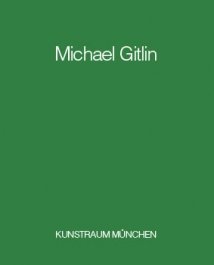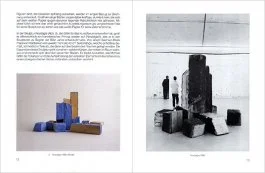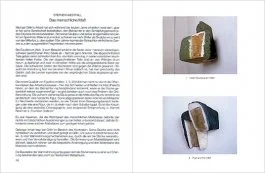Kunstram Munchen 1986
Humanizing Sculpture
by Stephen Westfall
Michael Gitlin’s work has altered considerably over the last several years but he has maintained a willingness to involve the viewer with the creation of each piece. In his sculpture and roughly physical plywood paintings (at least they appear to be more paintings than sculpture) from the mid to late 70s, the viewer could reconstruct a former whole from the fragments on view. In “Equilibrium” (fig. 3), for instance, he pares the sides most of the way down a massive square column of wood painted black. The cut away sections reveal a narrow core, also square, in its natural bright blond color. The four sliced sections are suspended on the surrounding walls at the same height as the column’s remaining base. The black painted surfaces of the wood slats face the walls. Though the arrangement is almost ritualistically static, one has the sensation that the slats have somehow exploded off the original column.
The visceral quality of “Equilibrium” (fig. 3, p. 20) is felt not only through the evidence of work—the cut and tear into the wood (flesh) that the viewer participates in vicariously as he mentally reassembles the piece—there is also the matter of scale. The standing column, centered in the room, is taller than a man: a heroic figure. Its burst sides can be read as a metaphor for reach, the way dancers define their arena or a figure in the dark gropes for a switch. It is the crucifixion as an abstract choreography, a sculptural equivalent of Newman’s “Fourteen Stations.” It was Newman who emphasized the importance of human scale (which had no bearing on actual dimensions) and he insisted that the requisite for such a scale was content. Content for Gitlin lies in the realm of the concrete. His pieces are not symbolic, and yet by triggering the perceptual mechanisms through which we reconstruct and project completion and by activating the muscle memory through which we recognize labor and the resistance of material, Gitlin manages to draw us out of ourselves. The building blocks of cognition are revealed to be steppingstones to an experiential, as opposed to a symbolic, metaphysic.
In the exhibition at hand, the maquette of “Broken Infinity” (fig. 1) offers a glimpse of a shift of emphasis in Gitlin’s work. The green figure eight of painted wood bobbing and weaving out of the three adjoining rooms is in a presently completed state. Still, as before, the viewer must proceed to an image of the finished work in stages. Observers of the full scale work would be left in the role of the blind men describing an elephant from the part they each touched. The whole is extrapolated, again, from a series of fragments. Imagine the difficulty of moving around this piece. You’d have to duck and squeeze in order to even enter the middle room from the hallway. Everywhere the eye gazes, its effort to follow the movement of the work would be obstructed. When apprehension of the physically persuasive movement of the piece is interrupted, the jolt is physically felt.
Gitlin’s later wall objects, more spatially aggressive wall/floor sculptures and, clearly, the recent oil stick drawings, have all moved to a more gestural format; approaching completion as it were, rather than decaying from it. The change in attitude could be noticed in 1981 pieces such as “Unpredictable,” with its series of oblique angled cuts complicating the viewer’s perception of reconciliation between the three blocks (not illustrated). The plaster-skinned “Sentinel” (fig. 4), “Exposed” (fig. 6), and “Doublecut” (fig. 9) abandon any pretense to rejoinment. The volume that would heal the exposed wood is absent. Gitlin has subsequently dropped any suggestion of subtraction, at least until “Nostalgia” (1981-86), the ironically titled major installation in the present exhibition.
The openness of the recent wall constructions and the near choreographic work on paper invite the observer to participate in immediate movement rather than reassembly. You can almost hear the slap of the wood slatting coming together in space in “Your Head or Mine” (fig. 19), while the gestural white areas in the drawings buoying his jagged and directional linear figures make space as palpable as a solid. The process of the piece arriving at its present state is as open to inspection as before. Yet the viewer is caught up in a forward-looking attitude as opposed to an elegiac one. Gitlin seems to know the difference, as the Orphic title of his large installation suggests.
“Nostalgia” (fig. 2) is clearly more reflective of Gitlin’s earlier concerns. The rectangular columns bound together all have a piece cut out from them. Each fragment is laid out in the room and the spectator may recreate the original unviolated block. The light blue paint covering the outer surface of the columns (except, of course, where the cuts take place) playfully undercuts the massiveness of the bound structure. It is as if Gitlin has returned to his more classically minimal forms without presupposing their sobriety.
A work of art is essentially a perceptual machine. It sets off a chain of reactive events within the viewer’s consciousness that may lead to contradictions as well as congruencies. But if it only does that then there is little difference between the artwork and a class science project. What makes Gitlin’s work special is its coexisting attitudes of no-frills execution and stylishness. His art holds your attention by making reference to and awakening your body. Once attracted by the way the continuous, powerfully twisting limbs of “Broken Infinity” (fig. 1) mimic human musculature, it becomes easy to get caught up in the sweep of its configuration axial alignments. You really want to do the work necessary to complete the piece in your mind’s eye. And you can almost project a yearning to recover what’s been lost among “Nostalgia’s” (fig. 1) oddly heroic bound columns. I find myself sensing a poignant nakedness where they’ve been cut, and a slight embarrassment at having the inventory of their loss laid out on the floor.
Gitlin has found that rough-hewn wood warms and humanizes geometric form. This concern for humanization extends into the art situation itself. His work is a formal, abstract theater that integrates the viewer into the performance; elevates him, in fact, to the primary role in a human drama of perception unfolding into larger sympathies.
Michael Gitlin in Münich
by Christine Tacke
Michael Gitlin’s Münich exhibition in April 1986 is devoted to the artist’s most recent work. The original intention was to show the installation “Nostalgia” in the Kunstforum, a collection of drawings in the Lenbachhaus, and the installation “Broken Infinity” in the Kunstraum München. However, organizational difficulties led to the cancellation of the Lenbachhaus exhibition, which meant that the plans had to be changed in order to ensure an adequate presentation of Gitlin’s work. The exhibition in the Kunstraum München now comprises drawings and sculptures.
It would nevertheless seem appropriate to comment briefly on the model of “Broken Infinity” (Fig. 1) since the piece was so specifically conceived for the Kunstraum München that it will probably never be realized anywhere else.
The artist’s intention was to install an endless strip in the shape of the mathematical symbol for infinity (Moebius strip), running through all the rooms in the gallery. Rather than being in one piece, the strip was to be manifestly ‘constructed’, using thick (7’8” x 7’8”) wooden beams, the aim being to present a deliberately cumbersome structure whose visual awkwardness would contrast sharply with the elegance of the mathematical formula for infinity. The strip was to be mounted on simple wooden supports of varying heights, so that instead of standing on one level it would run up and down in space, thereby emphasizing its physical presence. Here and there, it would burst through the wall. The bold green paint on the wood was intended to form a stark contrast to the white of the walls. There was to be no vantage point from which it would be possible to recognize the whole as a Moebius strip; the spectator was to see only fragments of a mysterious structure which would require considerable effort in order to attain a perception of its formal unity.
This process of striving for a perception of form raises the philosophical and scientific question of infinity, of the shift from the visible to the invisible, from appearance to idea. Whilst individual human existence is finite, the cosmos still poses the question of infinity. Is our finity a fragment of infinity?
Blaise Pascal notes: “When I consider the small span of my life absorbed in the eternity of all time, or the small part of space which I can touch or see engulfed by the infinite immensity of spaces that I know not and that know me not, I am frightened and astonished to see myself here instead of there . . . now instead of then. Or like the memory of a guest who stayed for one day and passed on.” (The Wisdom of Solomon 5.15) (1)
The advances in scientific knowledge concerning the cosmos (2) have repeatedly exploded and revolutionized our general image of the world and forced us to revise the way in which we think about the universe. (3)
More and more, the fragmentary character of our knowledge of things is tending to produce a longing for harmony, for a unified vision which will embrace the entire cosmos, integrating all its parts into a perfect whole.
The majority of Michael Gitlin’s sculptures consist of fragments, which are open to, and indeed require, augmentation by thought on the part of the spectator. The installation “Broken Infinity” on the other hand, would have shown a fragmented whole, a new departure in Gitlin’s work.
Something of this sense of fragmentation is conveyed by Michael Gitlin’s drawings. The lines, which constantly stop and start afresh, frequently attempt to assert themselves on a particular level. Other lines come in to oppose them, a conflict of levels ensues, and one receives the impression that the lines are trying to break away from the flat surface of the paper and move out into space. The lines at the front of the visual field shift into the background, from which other lines emerge and thrust themselves into the foreground. Their constant restless movement draws the spectator into the space which they define.
(1) Blaise Pascal, “Pensées et Opuscules,” Pensée No. 205, Leon Brunschwicg, ed., Paris 1961, p. 427, cit. by Rudy Rucker, Infinity and the Mind, Boston/Basel/Stuttgart 1982, p.2. (original text: Quand je considére la petite durée de ma vie, absorbee dans l’éternité précédente et suivante, le petit espace que je remplis et même que je vois, abîme dans l’infinie immensité des espaces que j’ignore et qui m’ignorent, je m’effraie et m’étonné de me voir ici plutôt que la, car il n’y a point de raison pourquoi ici plutôt que la, pourquoi a present plutôt que lors: qui m’y a mis? par I’ordre et la conduite de qui ce lieu et ce temps a-t-il ete destiné a moi? Memoria hospitis unius diei praetereuntis. Sagesse, V, XV.)
(2) For an account of the latest advances in cosmological research, see Edward R. Harrison, Cosmology, The Science of the Universe, Cambridge University Press, Cambridge 1981
(3) The Big Bang theory fails to account for what preceded the big bang (nothingness, a vacuum?) or to answer the question whether the universe is expanding or, on the other hand, contracting and thereby tending to a state of nothingness.
The Broken Line
by Helmut Friedel
Michael Gitlin’s artistic method is based on the principle of division. His pieces from the period 1974–1980 take the form of severed and broken wooden panels, whose rough edges bear the marks of brute force. The material itself, wood, lends these ‘tableaux’ a particular air of density and solidity, with the result that the severed individual sections of the pieces enjoy an additional spatial freedom beyond their surface extension. They stand out in relief against the wall, which forms a backdrop to the movement of the pieces and thus becomes a part of the overall pictorial effect. An important role is played by Gitlin’s practice of painting the panels before severing them. The surface of one side is generally coated with black latex paint which contrasts sharply with the white wall and provides a graphic effect. The rough edge appears as an ordering line, along which the separate elements of the pieces are set at an angle to each other. In a series of these pictures, the manner of severing the wood is offset by the way in which the front and rear surfaces are alternately exposed, thus establishing, in the most simple fashion possible, a spatial organization of depth. Taking these basic formal possibilities as his point of departure, Gitlin’s obvious next step was to expand his work spatially, both in terms of the surface area of the pieces and in respect to their three-dimensional presence. Hence an almost continuous development can be seen in which the originally flat surfaces take on the character of sculpture, turning out from the wall and extending into space.
At the start of this development, Gitlin uses heavy blocks of wood which are sawn into solid shapes. He is interested not only in the external surface of the shape, but also in the aspect of its volume, its underlying rear surface, as it were. These bulky wooden forms, with their board-like planes, have a cubist structure. The painted sur-face remains an important element in these sculptures; the paint is allotted the function of indicating the original outer surface of the solid body. Between 1981 and 1983, Gitlin does more and more of this kind of ‘decoration’, covering his sculptures with layers of paint up to an inch thick. The point of this practice becomes obvious: the outer coating of paint forms a protective shell, from which the wood beneath emerges like the kernel of a nut.
In his work from the years 1984 and 1985, Michael Gitlin would appear to have adopted and strictly adhered to an approach which involves dispensing with the solid core of his sculptures and only showing the external surface. Hollow forms are constructed from thin pieces of wood and painted all over; the pieces are large and spatially demanding. These more recent sculptures, which often have a fragmented look, are complex figures whose development is closely related to Gitlin’s drawings. The bold dark lines of the large-format drawings stand out clearly on the white paper against the layers of paint on which they are superimposed. There is a parallel to be seen between the contrastive function of the white paper for Gitlin’s drawing and the way in which he uses the white gallery walls as a background for his sculptures.
In his sculpture “Nostalgia” (Fig. 2), which was specifically conceived for the Kunstforum, Gitlin returns (nostalgically?) to an artistic principle which he first formulated in his sculptures at the beginning of the 1980s. The basis of the work is a block of six wooden beams with a side measurement of over 40 cm, which have been painted light blue. Sections of the beams have then been sawn off and laid out on the floor. The sculpture thus extends outwards from a fixed body in the center of the room and occupies the whole of the space. It remains to be seen how Michael Gitlin will use the space in the Kunstforum to order the discrete, fragmented elements of the sculpture and combine them into a central controlling image.


